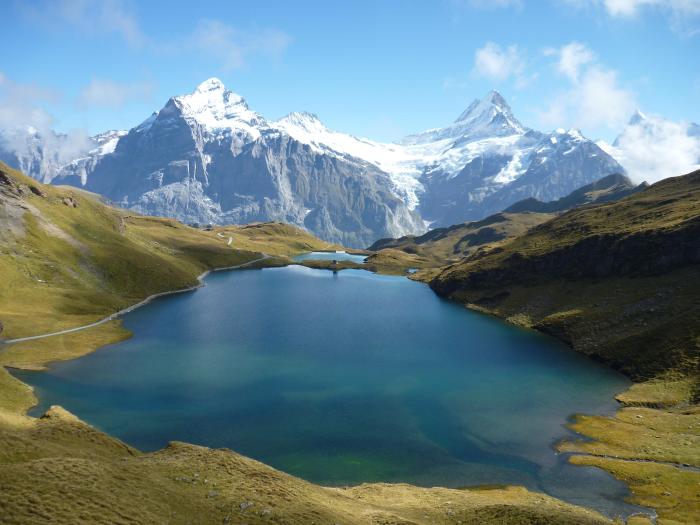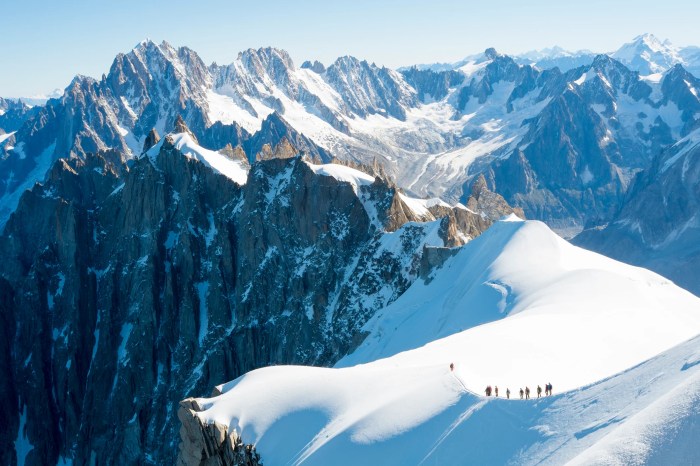The Alps, a majestic mountain range spanning across Europe, beckon us with their captivating beauty and rich tapestry of history, culture, and adventure. From their towering peaks to their verdant valleys, the Alps have inspired awe and wonder for centuries.
Their geological formation, shaped by the collision of tectonic plates, has resulted in a breathtaking landscape of towering peaks, pristine lakes, and lush forests. The Alps are a haven for biodiversity, supporting a unique ecosystem of flora and fauna.
Geography and Geology

The Alps are a majestic mountain range that stretches across eight countries in Europe, forming a formidable barrier between the Mediterranean Sea and the rest of the continent. They extend for approximately 1,200 kilometers (750 miles) from France in the west to Slovenia in the east, with a width ranging from 120 to 200 kilometers (75 to 125 miles).
The Alps are renowned for their towering peaks, with many exceeding 4,000 meters (13,000 feet) in elevation. The highest peak in the Alps is Mont Blanc, which stands at an impressive 4,809 meters (15,774 feet) above sea level, located on the border between France and Italy.
Geological Formation
The Alps were formed as a result of the collision between the African and Eurasian tectonic plates, which began around 30 million years ago. As the African Plate pushed northward, it collided with the Eurasian Plate, causing the Earth’s crust to buckle and fold, resulting in the formation of the Alpine mountain range.
The Alps are composed primarily of sedimentary rocks, such as limestone, sandstone, and shale, which were deposited over millions of years by ancient oceans and rivers. These rocks have been uplifted and folded by the tectonic forces that shaped the mountains.
Major Peaks
The Alps are home to numerous prominent peaks, each with its own unique characteristics and challenges for climbers. The following table lists some of the major peaks in the Alps, along with their respective heights:
| Peak | Height (meters) |
|---|---|
| Mont Blanc | 4,809 |
| Monte Rosa | 4,634 |
| Dom | 4,545 |
| Weisshorn | 4,506 |
| Matterhorn | 4,478 |
Climate and Environment

The Alps are characterized by a diverse range of climate patterns, primarily influenced by altitude and geographical location. At lower elevations, the climate is temperate, with warm summers and mild winters. As altitude increases, the climate becomes colder and more humid, with heavy snowfall during the winter months.
The Alps, a majestic mountain range stretching across Europe, offer breathtaking landscapes and endless opportunities for adventure. If you seek adrenaline-pumping experiences, consider an extreme sports vacation in the Alps. From skiing and snowboarding to paragliding and rock climbing, the region caters to every thrill-seeker.
After an exhilarating day on the slopes or in the air, retreat to cozy chalets nestled amidst the stunning Alpine scenery.
The Alps are particularly sensitive to the effects of climate change. Rising temperatures have led to the melting of glaciers, which has had a significant impact on the local water supply and ecosystems. Changes in vegetation have also been observed, with tree lines moving to higher altitudes.
Unique Flora and Fauna, Alps
The Alpine ecosystem is home to a wide variety of unique flora and fauna. Some of the most notable species include:
- Alpine ibex: A mountain goat found in the high Alps.
- Marmot: A large rodent that lives in burrows.
- Edelweiss: A small, white flower that is a symbol of the Alps.
- Alpine chough: A bird that is known for its distinctive red beak and legs.
- Alpine newt: A small, brightly colored amphibian that lives in mountain streams.
History and Culture: Alps

The Alps have been home to human habitation for thousands of years, with evidence of prehistoric settlements dating back to the Neolithic period. The region’s rich history is reflected in its diverse cultural traditions and languages.
Human Habitation
The earliest known inhabitants of the Alps were nomadic hunter-gatherers who lived in the region during the Ice Age. As the climate warmed, these groups gradually transitioned to a more settled lifestyle, establishing villages and practicing agriculture.
During the Bronze Age, the Alps became a major center for metalworking, with evidence of copper and bronze mines and foundries throughout the region. The Iron Age saw the arrival of the Celts, who introduced new technologies and cultural practices to the Alps.
Cultural Traditions
The Alps are home to a diverse array of cultural traditions, reflecting the region’s long history and geographic isolation. These traditions include traditional music, dance, and crafts, as well as unique culinary specialties.
The alps, a magnificent mountain range stretching across Europe, offer breathtaking views and endless opportunities for outdoor enthusiasts. But did you know that you can experience a piece of the alps right in the heart of Chicago? The adler planetarium features a state-of-the-art planetarium that takes you on a journey through the cosmos, complete with stunning visuals and immersive sound effects.
Afterward, step outside and admire the breathtaking views of the alps from the planetarium’s observation deck.
One of the most famous cultural traditions of the Alps is yodeling, a type of singing that uses rapid changes in pitch. Yodeling is believed to have originated as a way for herders to communicate with each other over long distances.
The Alps offer breathtaking scenery and endless opportunities for adventure. Whether you’re looking to hike, ski, or simply relax in the stunning natural beauty, there’s something for everyone. And if you’re looking for a truly luxurious experience, be sure to check out our luxury travel deals.
We offer a wide range of exclusive packages that will make your Alpine adventure unforgettable. From private guided tours to five-star accommodations, we have everything you need to create the perfect trip. And with our exclusive deals, you can save big on your dream vacation.
So what are you waiting for? Start planning your Alpine adventure today!
Languages
The Alps are also home to a variety of languages, reflecting the region’s diverse history and cultural influences. These languages include French, German, Italian, Romansh, and Ladin.
French is the most widely spoken language in the Alps, followed by German. Italian is spoken in the southern Alps, while Romansh and Ladin are spoken in isolated valleys in Switzerland and Italy, respectively.
| Event | Date |
|---|---|
| First human settlements | Neolithic period (c. 6000 BCE) |
| Bronze Age metalworking | c. 2000 BCE |
| Arrival of the Celts | c. 500 BCE |
| Roman conquest | 15 BCE |
| Fall of the Roman Empire | 5th century CE |
| Rise of the Holy Roman Empire | 962 CE |
| Swiss Confederation | 1291 CE |
| French Revolution | 1789 CE |
| Napoleonic Wars | 1803-1815 CE |
| Unification of Italy | 1861 CE |
| World War I | 1914-1918 CE |
| World War II | 1939-1945 CE |
| European Union | 1993 CE |
Tourism and Recreation

The Alps offer a wide range of tourist attractions, drawing visitors from around the world. The stunning natural beauty of the mountains, with their towering peaks, glaciers, and crystal-clear lakes, provides a breathtaking backdrop for outdoor activities. From hiking and skiing to cultural exploration, there is something for everyone in the Alps.
Tourism is a major economic driver for the Alpine regions, providing employment and revenue for local communities. However, it also brings challenges, such as environmental degradation, overcrowding, and the commodification of traditional cultures. Striking a balance between economic development and environmental conservation is essential for the sustainable future of tourism in the Alps.
Hiking Trails
The Alps are home to some of the most famous and challenging hiking trails in the world. These trails offer hikers the opportunity to experience the beauty of the mountains up close, with breathtaking views and a sense of accomplishment upon reaching the summit.
- Tour du Mont Blanc: This classic trail circumnavigates Mont Blanc, the highest mountain in the Alps. It is a challenging but rewarding trek that takes hikers through stunning alpine scenery.
- Alta Via 1: This trail traverses the Dolomites, a UNESCO World Heritage Site known for its dramatic peaks and beautiful valleys.
- E5 European Long Distance Path: This trail runs from the Atlantic Ocean to the Adriatic Sea, passing through the Alps along the way. It is a long but rewarding hike that offers hikers a chance to experience the diversity of the Alpine landscape.
Arts and Literature
The towering peaks and breathtaking landscapes of the Alps have long been a source of inspiration for artists and writers. From majestic paintings to evocative sculptures and captivating literature, the Alps have played a pivotal role in shaping the development of artistic and literary movements.
Paintings
The Alps have captivated the imaginations of painters for centuries. Their rugged grandeur and ethereal beauty have been captured on canvas by renowned artists such as:
- J.M.W. Turner: His dramatic landscapes, such as “The Pass of Glencoe” (1811), showcase the awe-inspiring power of the mountains.
- Caspar David Friedrich: His Romantic paintings, such as “The Wanderer above the Sea of Fog” (1818), depict the sublime vastness of the Alps.
li>Ferdinand Hodler: His Symbolist paintings, such as “The Matterhorn” (1900), evoke a sense of the mountain’s towering presence.
Sculptures
The Alps have also inspired sculptors, who have sought to capture the majesty and scale of the mountains in three-dimensional form. Notable examples include:
- Auguste Rodin: His bronze sculpture “The Thinker” (1880-1882) depicts a solitary figure contemplating the vastness of the Alps.
- Alberto Giacometti: His elongated and fragmented sculptures, such as “Man Walking” (1949), convey the sense of isolation and vulnerability in the face of the mountains.
Literature
The Alps have been a fertile ground for literary inspiration. From epic poems to lyrical prose, the mountains have provided a backdrop for countless stories and characters. Some notable works include:
- Johann Wolfgang von Goethe: His poem “Prometheus” (1774) depicts the struggle of the human spirit against the unforgiving forces of nature.
- Mary Shelley: Her novel “Frankenstein” (1818) features the iconic scene where the monster is created in the Alps.
- Ernest Hemingway: His short story “The Snows of Kilimanjaro” (1936) explores the themes of mortality and redemption against the backdrop of the Alps.
Ultimate Conclusion
The Alps continue to captivate our imaginations, offering a realm of endless exploration and discovery. Whether it’s through hiking amidst their stunning scenery, skiing down their pristine slopes, or delving into their rich cultural heritage, the Alps beckon us to experience their timeless allure.
Essential Questionnaire
What is the highest peak in the Alps?
Mont Blanc, with an elevation of 4,808 meters (15,774 feet).
What countries are the Alps located in?
France, Italy, Switzerland, Austria, Germany, Slovenia, and Liechtenstein.
What is the best time of year to visit the Alps?
Summer (June-August) for hiking and outdoor activities, and winter (December-February) for skiing and snow sports.